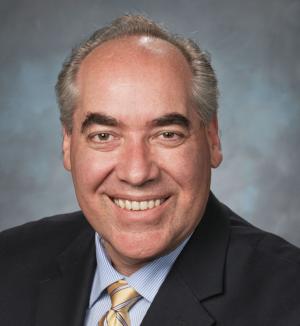Program Description
The LDRD program’s targeted investments allow LLNL to develop cutting-edge capabilities and foster innovation in key programmatic areas.
Director’s Statement

LLNL Director
As Lawrence Livermore National Laboratory’s most significant resource for supporting internally directed research and development, the LDRD Program provides investments in cutting-edge science and technology that allow the Laboratory to attract and retain the world’s most talented scientists and engineers and enables them to expand the frontiers of knowledge and anticipate emerging national security challenges. In this annual report, we summarize how Lawrence Livermore National Laboratory (LLNL) uses LDRD investments to advance our knowledge in strategic science and technology domains, develop our world-class workforce, and foster innovation in key programmatic areas.
LDRD investments foster mission agility through multidisciplinary research, bringing together diverse teams and collaborators to explore higher-risk, innovative approaches and concepts to fulfill our mission goals. This past year LLNL achieved a historical accomplishment -- on Dec. 5, 2022, LLNL demonstrated fusion ignition for the first time in a laboratory setting. The ground-breaking experiment did not happen overnight; rather it was the result of many innovations, developed over decades by pioneering scientists and engineers at NNSA’s national laboratories, working in collaboration with colleagues at other DOE/NNSA Labs and other research institutions. Many of those pioneering new ideas were transformed into solutions through funding provided by Laboratory Directed Research and Development Programs at NNSA Labs. LDRD investments in this foundational work over the last three decades spanned key science and technology areas, including target fabrication, diagnostic tools, and laser-plasma interactions. Since that day in December of 2022, we have achieved fusion ignition three more times – each time learning more and advancing our capabilities. Achieving fusion ignition provides critical insights into physics at extreme conditions essential to key LLNL nuclear deterrence missions and is an important step towards a zero-carbon energy future.
Spanning LLNL’s missions, LDRD investments bring together diverse teams and collaborators to push the frontiers of science, technology, and engineering to ensure the technical vitality of the Laboratory and continued impact on global and national security. For example, investigators are using the Laboratory’s powerful computers along with state-of-the-art experimental facilities to achieve new understanding across broad disciplines including high energy density science, advanced computing and data science, materials and manufacturing, bioscience and bioengineering, and earth and atmospheric science. Our LDRD program cultivates the creativity of the Lab’s most important resource—our workforce. LDRD-sponsored research enables outreach to tomorrow’s innovators, as we mentor students, challenge our postdoctoral researchers, and develop the leadership capabilities of early career staff. Mentorship is a hallmark of our program. A multidisciplinary group of senior scientists and advisors encourage our staff to pursue new research directions.
As you browse this report, you will learn about cover-page publications, patents, and science awards that resulted from LDRD investments. Throughout this year’s report, we highlight LDRD’s investments in areas that make the world a safer place. We review key accomplishments and performance indicators and share highlights from projects led by our talented staff. I encourage you to visit our LDRD website to learn about the more than 260 projects we supported during fiscal year 2023.
Looking to the future, I am confident that LDRD investments will continue to help LLNL remain at the forefront of innovative research and development, positioning us to solve the most complex global and national security challenges.
Mission Alignment
Congress established the Laboratory Directed Research and Development (LDRD) program in 1991 to foster cutting-edge scientific and technical vitality at U.S. Department of Energy (DOE) laboratories. The LDRD programs at each laboratory are a unique resource, providing funding for critical research aimed at addressing today’s needs and tomorrow’s challenges. LLNL’s program addresses DOE objectives, while also aligning with National Nuclear Security Administration (NNSA) mission objectives and the Laboratory’s own strategic priorities.
As articulated in DOE Order 413.2C, the LDRD program serves to:
- Maintain the scientific and technical vitality of the laboratories.
- Enhance the laboratories’ ability to address current and future DOE/NNSA missions.
- Foster creativity and stimulate exploration of forefront areas of science and technology.
- Serve as a proving ground for new concepts in research and development.
- Support high-risk, potentially high-value research and development.
Alignment with NNSA Mission Objectives
A strategic framework—created jointly by NNSA, LLNL, and the other NNSA laboratories—articulates the focus of LDRD programs at NNSA laboratories. LDRD investments support the following NNSA objectives:
- Technical Vitality. Develop innovative capabilities that are required to respond to emerging national security challenges.
- Mission Agility. Enable agile responses to national security challenges by investing in research and development at the forefront of mission-critical science and technology.
- Workforce Development. Recruit, develop, and retain the best and brightest staff, who can help us creatively address tomorrow’s dynamic mission needs.

Alignment with Laboratory Missions
In addition to aligning our LDRD investments with DOE and NNSA objectives, we ensure that our LDRD program supports mission priorities articulated in LLNL’s annual strategic investment plan. Institutional goals are established and updated through a planning process where multidisciplinary teams identify:
- Mission-related challenges or areas of interest for high-priority research.
- The core competencies that support this high-priority research.
- The scientific and technological needs to address those challenges and enhance related competencies.
- Key topics in fundamental research.
Program Oversight

LLNL Deputy Director for Science and Technology
Day-to-day oversight of our program is provided by LDRD Program Director Doug Rotman. Overall program oversight extends beyond the LDRD program office to include the LLNL Director and the LLNL Deputy Director for Science and Technology, along with the Laboratory’s scientific and programmatic leaders. This Laboratory team works closely with NNSA’s Livermore field office, NNSA’s LDRD program leaders, and LDRD program leaders at the Department of Energy.
At the programmatic level, LDRD portfolio management at Livermore is structured to assure alignment with DOE, NNSA, and Laboratory missions. Designated LDRD points of contact for each of the Laboratory’s strategic investment areas provide input regarding LDRD investment priorities to Livermore’s senior leadership team. These points of contact also advise applicants for LDRD funding regarding the alignment between proposed research and evolving mission needs at our Laboratory.
In addition, programmatic leaders and science and technology leaders spend a combined 3,000 hours in a rigorous peer-review process of all proposals for LDRD funding. They evaluate the scientific and technical impact of each proposal, as well as its technical content and project execution plan. NNSA reviews and concurs on funding decisions. Funded projects are periodically reviewed by senior staff to ensure technical success and continued alignment with mission objectives.
"LLNL’s Investment Strategy for Science and Technology is updated annually to reflect evolving mission needs, under the guidance of LLNL’s deputy director for science and technology. It sets the strategic context for LLNL’s annual call for LDRD proposals, and it serves as a resource for investigators as they articulate the ways their proposed research aligns with at least one of these investment priorities."
Performance Assessment

LDRD Program Director
The LDRD program achieves continuous improvement through internal and external reviews of the program, along with oversight of each LDRD research project. Representatives from LDRD programs at each NNSA laboratory regularly participate in working groups to share best practices and discuss strategies for tracking the long-term impact of LDRD investments.
To assess continued LDRD performance, the LDRD program tracks a suite of short-term and long-term metrics. These performance metrics can be found in the Program Value section of this report and address scientific publications, intellectual property, collaborations, and support for early career staff. Also included are NNSA guided metrics for assessing the long-term impact of LDRD on laboratory staff and capabilities. Our report also includes performance indicators specified by DOE’s director of LDRD programs, in accordance with DOE Order 413.2C.
“The LDRD program is an investment in our nation’s future, with a mission impact that is often realized many years after an LDRD-sponsored project concludes. I’m extremely proud of everyone at LLNL—from postdocs who serve on LDRD-funded research teams, to senior scientists who help shape our investment strategy—so that together, we can ensure that the LDRD program continues to serve as a valuable national asset.”
Investment Portfolio
LDRD investments span a broad range of research topics, helping to ensure that LLNL supports innovation in key programmatic areas. Funded projects address some of our newest mission spaces, including cognitive simulation, predictive biology, space science and security, and hypersonic science. We also invest in the core capabilities and programmatic areas that undergird our Laboratory’s technical vitality and mission agility.
For fiscal year 2023, we carefully structured Livermore’s LDRD investment portfolio to promote the short-term objectives and long-term goals of DOE, NNSA, and our Laboratory. The key metrics presented here regarding our FY23 investment portfolio reflect this structure, including how funds are distributed across the program’s 5 types of projects and 18 research categories. By strategically selecting the types of projects we fund, along with the amount of funding invested in each project, we help ensure a strong program portfolio.
Types of LDRD Projects and Number of Projects Funded in FY23
| Project Type | FY23 Projects Funded | Project Aim |
|---|---|---|
| Exploratory Research (ER) |
141 |
Address a specific research challenge or enhance a core competency. |
| Feasibility Study (FS) |
60 |
Determine the viability of a new way to address a mission-relevant challenge. |
| Lab-wide (LW) Competition |
37 |
Conduct innovative basic research and enable out-of-the-box thinking. |
| Strategic Initiative (SI) |
19 |
Make significant progress addressing a mission-relevant challenge from a multidisciplinary perspective. |
| Disruptive Research (DR) |
9 |
Pursue novel ideas with the potential to overturn fundamental paradigms or create new research directions. |








